High Income Parents Experiencing Mental Health Effects of COVID-19; Higher Rates of Substance Use

New Survey Finds Low Income Parents Stressed & Depressed During Ongoing COVID-19 Pandemic; High Income Parents Using More Substances to Cope
As the U.S. continues to respond to the COVID-19 pandemic, back-to-school decisions have been made or are being discussed in family rooms and schools across the country. We recently surveyed 1,000 parents of school-age children to learn more about their kids’ mental health symptoms and attitudes about going back to school.
While all families reported similar rates of going back to school in-person or staying virtual, other fall semester considerations were very different when we looked at the results based on reported income level. Kids from high income households were more likely to have expressed concern about going back to school (73.4%) compared to school kids from low income households (42.5%). They were also more likely to be vaccinated (61% compared to 31%) or plan to vaccinate once their kids are old enough (67% compared to 37%).
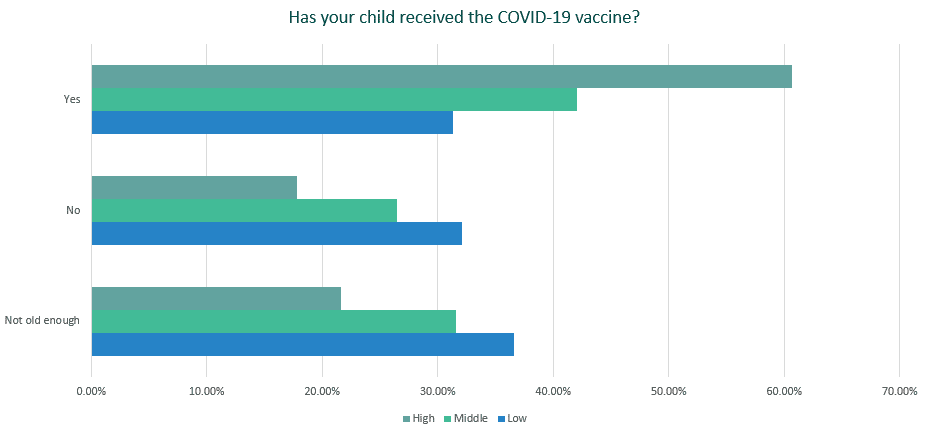
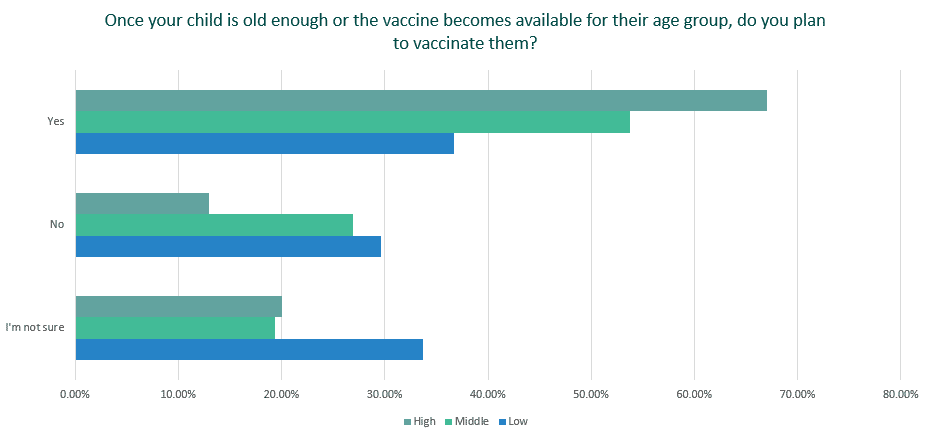
Here’s what else we found.
The Recovery Village Survey Results by Income Level
We surveyed 1,000 parents of K-12 students about their kids’ mental health, behavior and attitudes about going back to school. We also asked the parents about their own mental health and past month use of drugs and alcohol. Note: Some questions asked respondents to select each option that applied, so in a few instances, the total percentage will be greater than one hundred.
When referring to household income level, we’ll define those groups as following:
- Lower income households = households making less than $49k annually
- Middle income households = households making between $50-99k annually
- High income households = households making over $100k annually
Low Income Parents More Stressed, Depressed & Unsure
We asked parents if they had experienced any adverse mental health symptoms over the past six months. A majority of all parents (65.4%) reported experiencing mental health symptoms, including 73% of high income parents. Low and middle income parents reported slightly lower rates (both 61%) but there were big differences in the specific symptoms reported.
- 64% of lower income parents reported symptoms of depression compared to 54% of high income parents.
- 61% of lower income parents reported feeling stressed compared to 43% of high income parents.
- Middle income parents reported anxiety at a lower rate (56%) than their high (69%) or lower income (72%) counterparts.
- Middle income parents were also much less likely to report feelings of anger/agitation (29%) than their low (43%) or high income (44%) peers.
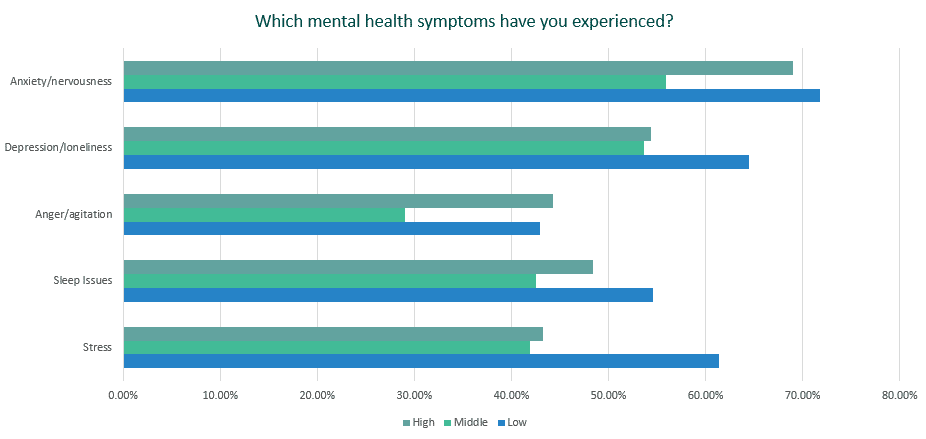
High income parents were much more likely to say that their mental health typically improves once their kids are back in school (69%) compared to just 35% of low income and 43% of middle income parents.
- 17% of lower and 19% of middle income parents said their mental health typically gets worse when kids are back in school. Only 10% of high income parents said the same.
- 47% of lower income parents said they weren’t sure what to expect this year. 38% of middle income and only 21% of high income parents said the same.
High Income Parents Using Drugs & Alcohol at Much Higher Rates
We asked survey participants if they had used illicit drugs or alcohol or misused a prescription medication over the past month. Misuse was defined as taking a higher dose or more frequently than prescribed or taking a prescription medication that was not prescribed to you.
High income households were significantly more like to report substance use:
- 65% of high income households
- 47% of middle income households
- 38% of lower income households
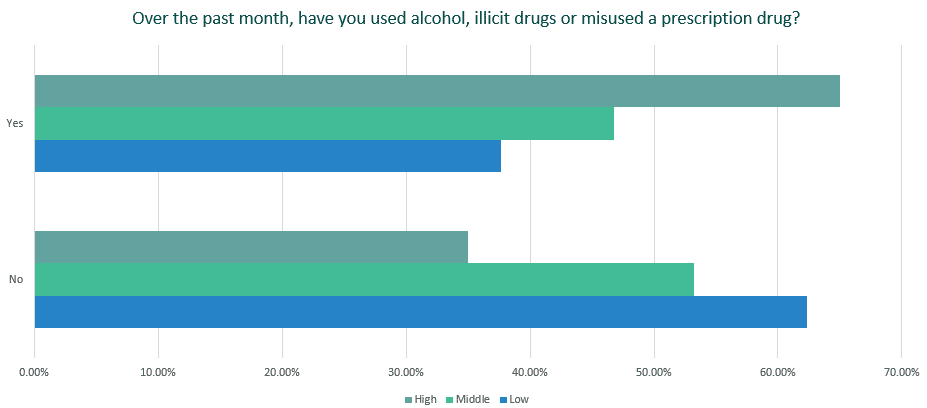
Rate of alcohol use: High and lower income respondents reported higher rates of past-month drug and alcohol use than middle income households:
- 75.4% of high income households
- 52.2% of middle income households
- 62.4% of lower income households
All households reported roughly similar rates of marijuana use and prescription stimulant misuse. High income parents reported significantly more use or misuse across all other types of drugs. Generally, reported rates increased with income level.
Prescription opioid misuse:
- 43.8% of high income households
- 28.3% of middle income households
- 19.8% of lower income households
Heroin/fentanyl use:
- 39.8% of high income households
- 19.6% of middle income households
- 16.8% of lower income households
Cocaine use:
- 34.4% of high income households
- 22.5% of middle income households
- 15.8% of lower income households
Benzodiazepine misuse:
- 29.3% of high income households
- 23.9% of middle income households
- 17.8% of lower income households
One exception was methamphetamine use. Both high (30.1%) and lower income (20.8%) parents reported higher rates than middle income parents (18.1%).
High Income Parents Report More Substance Use Due to Pain, Mental Health & Parenting Demands
We asked parents the reasons that prompted their substance use. Across the board, parents reported social or recreational drinking at similar rates (30-31%).
A majority of all groups selected coping with stress as the biggest reason for past-month substance use, but the parents on either end of the income spectrum were more likely to identify stress as the reason than middle income parents:
- 67.2% of high income households
- 44.2% of middle income households
- 57.4% of lower income households
High income parents were more likely to select other reasons for their substance use, compared to parents in other income levels.
To cope with mental health symptoms:
- 57.4% of high income households
- 44.2% of middle income households
- 41.6% of lower income households
To cope with parenting demands:
- 42.2% of high income households
- 28.3% of middle income households
- 22.8% of lower income households
Another concerning finding: 30.5% of high income parents reported being physically dependent and 36.3% reported using substances to treat pain. Middle income parents (19.6%) were slightly more likely than lower income parents (17.8%) to report being physically dependent. More than a third of the lower income parents selected pain management (34.7%) but middle income parents weren’t far behind (28.3%).
Using substances for these reasons increases the risk of developing a substance use disorder. Physical dependence can make quitting uncomfortable or even dangerous, depending on the substance used.
Substance use as a way to self-medicate stress or other mental health concerns can actually exacerbate mental health symptoms and consistent or long-term use can also lead to dependence or addiction. These results show us that there is a critical need to encourage the use of healthy coping strategies and deliver better mental health support to parents, regardless of income.
High Income Kids Experiencing “Significant” COVID-19 Impact to Mental Health; Engaging in More Risky Behaviors
In addition to questions about parents’ mental health, we asked about children’s mental health, symptoms and behaviors. All three income groups reported that COVID-19 has impacted their childrens’ mental health. More high income parents felt their kids were impacted significantly.
- 52% of high income parents reported a “significant” impact to their kids’ mental health compared to 37% of middle and 27% of lower income parents.
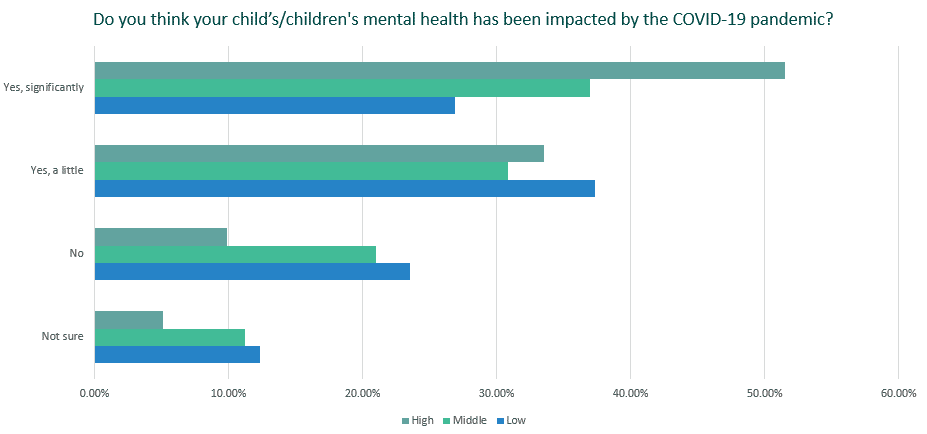
There were some slight variations in the specific symptoms reported:
- High income parents reported noticing anxiety at a higher rate (64.2%) than middle (50.5%) or lower income parents (55.8%).
- High (39.4%) and lower income parents (37.8%) noticed higher rates of sleep issues than middle income parents (33.5%).
- Symptoms of depression and anger/agitation increased as income level rose.
- 47.7% of lower, 49% of middle and 52.8% of high income parents reported depression
- 33.7% of lower, 38% of middle and 40% of high income parents noticed anger/agitation
All income levels reported similar rates of stress (38-42%).
One troubling finding from the survey: 62% of parents reported observing their child engaging in risky behaviors. Lower income parents were the least likely to have observed these kinds of behaviors: 49% of lower income parents said they had not observed any of the risky behaviors listed compared to 36% of middle and 29% of high income parents said the same.
Once again reported rates of the following behaviors rose with income level.
Alcohol use:
- High income: 38.3%
- Middle income: 23.1%
- Lower income: 14.6%
Drug use:
- High income: 28.7%
- Middle income: 19%
- Lower income: 7.8%
Disordered eating:
- High income: 32.5%
- Middle income: 27.1%
- Lower income: 17.5%
Withdrawing or self-isolating from family/friends:
- High income: 34.5%
- Middle income: 22.4%
- Lower income: 24.6%
These results show that increased income level doesn’t necessarily protect kids’ mental health and there’s still a great number of kids who could benefit from mental health interventions so that they’re utilizing healthy coping strategies in their lives instead of the risky behavior reported.
K-12 Parents and Children Need More Mental Health Support
As the impact of COVID-19 pandemic lingers, families are making decisions about going back to school, fall activities and even looking ahead to the upcoming holiday season. These results demonstrate a strong need for parents to make mental health a focus of the back-to-school planning process, both for themselves and their children.
Managing mental health symptoms and getting support for stopping substance use are important ways to invest in your overall health and wellness, as well as the health and wellbeing of your family. Our new app, Nobu offers parents free, on-demand resources to learn about and improve mental health. Nobu is backed by proven strategies and techniques to address mental health symptoms and improve overall wellness to help with goals like:
- Reducing anxiety
- Working through depression
- Improving relationships
- Building self-esteem
- Understanding trauma
- Navigating nutrition
- Mindfulness
- Improving relationships
- Getting better sleep
- Ongoing aftercare following addiction treatment
For those in need of additional support, Nobu has premium features that connect you to a licensed mental health professional to schedule appointments and attend teletherapy sessions right from the app.
If you or your teen is struggling with substance abuse, we’re here to help. Contact us today to learn more about our addiction treatment facilities, programs and a care plan that can help you begin your recovery journey.
For press inquiries, email [email protected].
Our Other COVID-Related Studies:
- Workers’ Mental Health is Getting Worse, Not Better in 2021
- Employers Response to COVID’s Impact on the Workforce
- Survey Shows Drug and Alcohol Use on the Rise During COVID-19 Pandemic
- Mental Health in the Time of COVID-19
- Kids Anxious About Going Back to School After COVID
- Survey: Nearly 60% of School-Age Kids Anxious About Going Back to School in 2021
- Young Adults Turning to Drugs & Alcohol to Cope with COVID Stress
- Is COVID-19 Fueling the Next Opioid Epidemic?
Florida Department of Health. “Florida’s COVID-19 Data and Surveillance Dashboard.” Accessed August 19, 2020.
Goldstein, Amy. “Income emerges as a major predictor of c[…]ons, along with race.” Washington Post, June 22, 2020. Accessed September 11, 2020.
Rugaber, Christopher. “More businesses are realizing their ‘t[…]may become permanent.” Chicago Tribune, May 10, 2020. Accessed September 11, 2020.
Thriving Mind South Florida. “Groundbreaking for mental health center […]ly breaks new ground.” Florida Trend, June 27, 2019. Accessed September 14, 2020.
The Recovery Village aims to improve the quality of life for people struggling with substance use or mental health disorder with fact-based content about the nature of behavioral health conditions, treatment options and their related outcomes. We publish material that is researched, cited, edited and reviewed by licensed medical professionals. The information we provide is not intended to be a substitute for professional medical advice, diagnosis or treatment. It should not be used in place of the advice of your physician or other qualified healthcare providers.